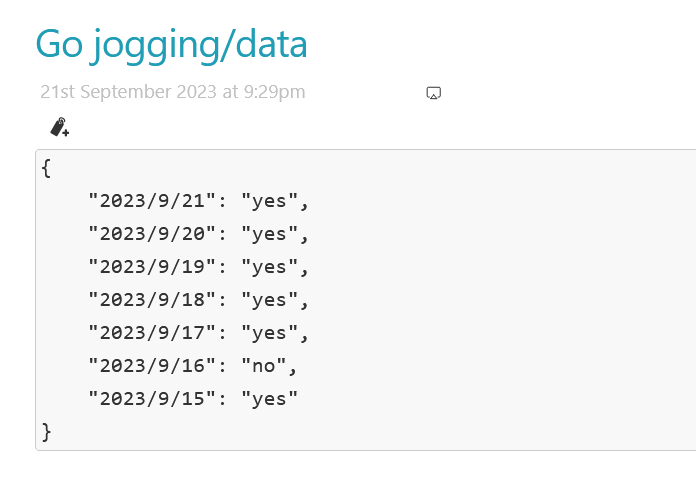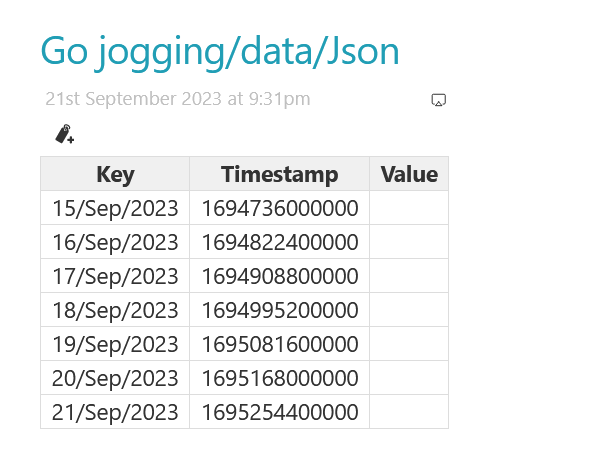Hi @andrewg_oz
I appreciate your work on TiddlyWiki charting and I’ve been exploring your plugins. Nice job, thanks for sharing! 
May I suggest some improvements in your examples?
In your example tiddlers, you often use this code pattern for value series:
<$list counter="is" filter="[[$:/plugins/tiddlywiki-scss-com-au/chartjs]plugintiddlers[]]">
<$text text={{{ [<is-first>match[no]then[,]] }}}/>
<$text text={{{ [<currentTiddler>]+[get[text]length[]] }}}/>
</$list>
and then this for labels:
<$list counter="is" filter="[[$:/plugins/tiddlywiki-scss-com-au/chartjs]plugintiddlers[]]">
<$text text={{{ [<is-first>match[no]then[,]] }}}/>
"<$text text={{{ [<currentTiddler>]+[removeprefix[$:/plugins/tiddlywiki-scss-com-au/chartjs/]] }}}/>"
</$list>
Notice here the subtle variation with leading and trailing " around the second $text widget.
Example code borrowed from this tiddler.
There are repeated lines of code in both code blocks:
- The whole $list widget, which selects the source tiddlers holding the data
- The first $text widget, which adds a
, separator between values
The second point can be simplified by adding a +[join[,]] filter step to the values filter, which also obsoletes the counter="is" attribute of the $list widget, like this:
<$list filter="[[$:/plugins/tiddlywiki-scss-com-au/chartjs]plugintiddlers[]]">
<$text text={{{ [<currentTiddler>]+[get[text]length[]]+[join[,]] }}}/>
</$list>
This works for values, but not for labels because of the surrounding ", which can be replaced by a +[addprefix["]addsuffix["]] filter run:
<$list filter="[[$:/plugins/tiddlywiki-scss-com-au/chartjs]plugintiddlers[]]">
<$text text={{{ [<currentTiddler>]+[removeprefix[$:/plugins/tiddlywiki-scss-com-au/chartjs/]]+[addprefix["]addsuffix["]]+[join[,]] }}}/>
</$list>
These code blocs can be further simplified by merging $list filter inside $text filtered transclusion:
<$text text={{{ [[$:/plugins/tiddlywiki-scss-com-au/chartjs]plugintiddlers[]]+[get[text]length[]]+[join[,]] }}}/>
...
<$text text={{{ [[$:/plugins/tiddlywiki-scss-com-au/chartjs]plugintiddlers[]]+[removeprefix[$:/plugins/tiddlywiki-scss-com-au/chartjs/]]+[addprefix["]addsuffix["]]+[join[,]] }}}/>
This is more compact, but also less readable… Enter subfilter:
\define chartTiddlers() [[$:/plugins/tiddlywiki-scss-com-au/chartjs]plugintiddlers[]]
\define chartValues() [get[text]length[]]
\define chartLabels() [removeprefix[$:/plugins/tiddlywiki-scss-com-au/chartjs/]] +[addprefix["]addsuffix["]]
...
<$text text={{{ [subfilter<chartTiddlers>] +[subfilter<chartValues>] +[join[,]] }}} />
...
<$text text={{{ [subfilter<chartTiddlers>] +[subfilter<chartLabels>] +[join[,]] }}} />
The whole code before:
<$chartjs type=pie title="Plugin Composition" width=530px>{
"options":{"plugins":{"legend":{"position":"right"}}},
"data":{"datasets":[{"data":[
<$list counter="is" filter="[[$:/plugins/tiddlywiki-scss-com-au/chartjs]plugintiddlers[]]">
<$text text={{{ [<is-first>match[no]then[,]] }}}/>
<$text text={{{ [<currentTiddler>]+[get[text]length[]] }}}/>
</$list>
]}],"labels":[
<$list counter="is" filter="[[$:/plugins/tiddlywiki-scss-com-au/chartjs]plugintiddlers[]]">
<$text text={{{ [<is-first>match[no]then[,]] }}}/>
"<$text text={{{ [<currentTiddler>]+[removeprefix[$:/plugins/tiddlywiki-scss-com-au/chartjs/]] }}}/>"
</$list>]}}</$chartjs>
and after:
\define chartTiddlers() [[$:/plugins/tiddlywiki-scss-com-au/chartjs]plugintiddlers[]]
\define chartValues() [get[text]length[]]
\define chartLabels() [removeprefix[$:/plugins/tiddlywiki-scss-com-au/chartjs/]] +[addprefix["]addsuffix["]]
<$chartjs type=pie title="Plugin Composition" width=530px>{
"options":{"plugins":{"legend":{"position":"right"}}},
"data":{"datasets":[{"data":[
<$text text={{{ [subfilter<chartTiddlers>] +[subfilter<chartValues>] +[join[,]] }}} />
]}],"labels":[
<$text text={{{ [subfilter<chartTiddlers>] +[subfilter<chartLabels>] +[join[,]] }}} />
]}}</$chartjs>
I hope you liked this little journey, and thanks again for your plugins 
Fred

 (clue is in the domain name)
(clue is in the domain name)


